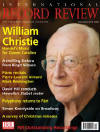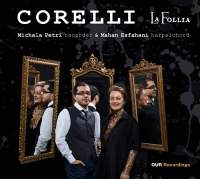Texte paru dans: / Appeared in:
*

International Record Review - (12//2014)
Pour
s'abonner / Subscription information
Our Recordings 6220610

Code-barres / Barcode : 0747313161065
Consultez toutes les évaluations recensées pour ce cd
~~~~ Reach all the evaluations located for this CD
The 300th anniversary of Arcangelo Corelli’s death passed unceremoniously in January 2013, though several record labels have since capitalized on this opportunity to thrust the composer back into the limelight. New traversals of Corelli's Op. 5 Sonatas from
‑the Avison Ensemble and Pavlo Beznosiuk on Linn and from the Trio Corelli on Bridge Records (reviewed in March 2013 and June 2012 respectively) have each afforded fresh , perspectives on this seminal group of pieces upon which, declared Dr Charles Burney in 1776, all good schools for the violin have since been founded.
Today, it is hard fully to appreciate the clamorous expectation with which new works by the great Italian master would have been awaited throughout Europe's musical capitals, and to understand bow, so soon after its publication, Corelli's music was often rearranged and transcribed for instrumental combinations for which it had never been intended, and from which wily publishers were always assured handsome profits.
It shouldn't surprise us either to find that many unauthorized and speculative revisions involved that most utilitarian of instruments, and part of the essential daily equipment for any civilized gentleman of letters, the recorder. This new‑disc from OUR Recordings featuring the acclaimed Danish virtuoso Michala Petri and former BBC New Generation Artist Mahan Esfahani accompanying on the harpsichord is one of several currently available which feature the recorder.
Textual material used here derives from a number of sources, primarily the original Roman printing of 1700. However, rather confusingly, it is an undated reprint for flute (otherwise recorder, where no flauto traverso was available, since both instruments were widely considered interchangeable at the time) issued by the London publisher John Walsh that furnishes the scores used here by Petri and Esfahani. The original frontispiece, which has been reproduced in the attractive and lavishly illustrated booklet, reassured the would‑be purchaser that the whole (in this case just the last six sonatas of Op. 5, the so‑called Sonate di Camera) has been exactly transposed and made fit for a flute and a bass, with the approbation of several eminent masters.
One need hardly add, of course, that Petri's performances are superlative, though for all their excellence, there's also no denying that the music loses something of its engaging effect because of the necessarily limited tonal palette of the recorder itself. Contemporary reports of Corelli's own' playing often suggested an element of almost Paganinian theatrics, with Roger North relating in 1728 that he never met any man that suffered his passions to hurry him away so much whilst he was playing upon the violin as the famous Arcangelo Corelli, whose eyes will sometimes turn red as fire; his countenance will be distorted, his eyeballs roll as in an agony, and he gives in so much to what he is doing that he doth not look like the same man!
There's no comparable diableric about these new accounts, however, and despite necessarily circumscribed expressive possibilities, Petri and Esfahani still manage to sound absolutely bewitching throughout this uncannily beautiful recording from Copenhagen's Garnisonskirken. Such is the musical chemistry between them that one soon becomes fully attuned to hearing this familiar music performed on the recorder.
Anyone after more varied takes on Corelli's Op. 5 Sonatas might well enjoy hearing Maurice Steger's fascinating 2010 Harmonia Mundi release, 'Mr Corelli in London', in which he plays a variety of what might today be called cover versions of these works with The English Concert directed by Laurence Cummings. They offer transcriptions in a wide variety of differing settings, as popularized back in the day by such figures as Geminiani (Corelli's disciple), Paisible, Castrucci, Babell and Loeillet, all of whom arranged these works in order to satisfy insatiable popular demand during the 1700s. Steger's playing is impressive enough, yet the principal virtue of this release is that the accompaniments themselves prove fascinatingly diverse.
Equally,
if you're happy enough with just harpsichord accompaniment alone, then look
no further than Petri's and Estahani's immaculately played and diligently
prepared new accounts, which seem in every way the last word in tasteful and
elegant musicianship, with a magical recording to boot. There are also the
capable and stylish Oehms performances from Stefan Temmingh and
harpsichordist Olga Watts, which are entirely recommendable, too, but whose
recorded sound lacks the bloom and sophistication of this new SACD version.
Fermer la fenêtre/Close window
Cliquez l'un ou l'autre
bouton pour découvrir bien d'autres critiques de CD
Click either button for many other reviews


